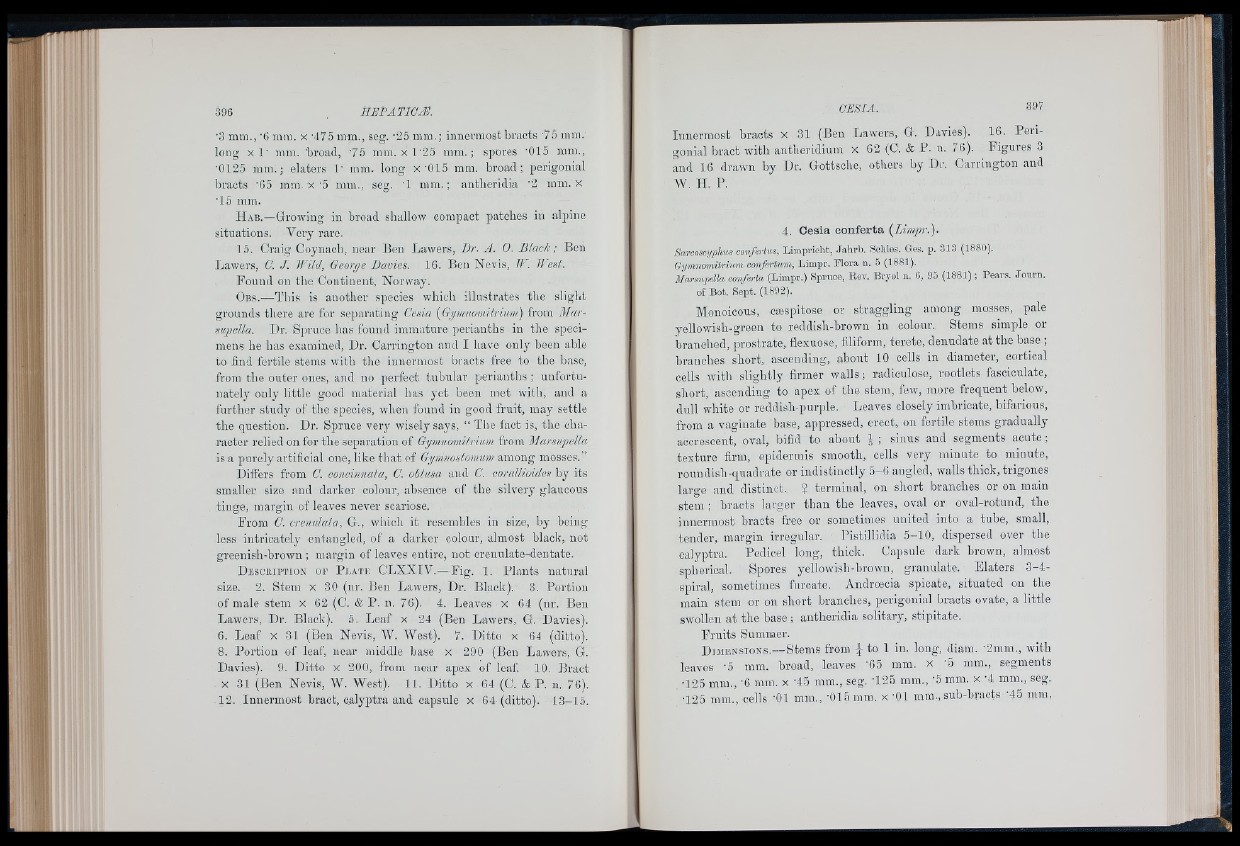
•3 mm., '6 mra. x '475 ram., seg. '25 mm.; innermost bracts '75 mm.
long x 1' ram. 'broad, '75 mm. x 1'25 mm.; spores '015 mm.,
•0125 mm.; elaters |- mm. long x '015 mm. broad; perigonial
bracts '65 mra. x '5 nim.. seo;. '1 mm.;O antiieridia '2 imii. x
'15 mm.
H ab.—Growing in broad shallow ooinpaot patches in alpine
situations. Very rare.
15. Craig Coynaoh, near Ben Lawers, Dr. A. 0. Black; Ben
Lawers, C. J. ll’ihl, George Davies. 16. Ben Nevis, //'. // est.
Found on the Continent, Norway.
Obs.—This is another species which illustrates the slight
grounds there are for sejiarating Cesia (Ggmiwmitriiiiii) from Marsupella.
l.)r. Spruce has found imniatui'e perianths in the specimens
he has e.\amined, Dr. Carrington and I have only been able
to find fertile stems with the innermost bracts free to the base,
from the outer ones, and no perfect tubular perianths; unfortunately
only little good material has yet been met with, and a
further studj' of the species, when found in good fruit, may settle
the question. Dr. Spruoe very wisely says, “ The fact is, the character
relied on for the separation of Gymnomitrium from Marsupella
is a purely artificial one, like that of Gymuoslomum among mosses.”
Difiers from C. couciunaia, C. obtusa and C. coralhoides by its
smaller size and darker colour, absence of the silvery glaucous
tinge, margin of leaves never soariose.
From C. crenulata, G., which it resembles in size, by being
less intricately entangled, of a darker colour, almost black, not
greenish-brown; margin of leaves entire, not oreniilate-dentate.
D e s c i u p t i o n o e P l a t e CLXXIV. — Fig. 1. Plants natural
size. 2. Stem x 30 (nr. Ben Lawers, Dr. Black). 3. Portiou
of male stem x 62 (C. & P. n. 76). 4. Leaves x 64 (nr. Ben
Lawers, Dr. Black). 5. Leaf x 24 (Ben Lawers, G. Davies).
6. Leaf x 31 (Ben Nevis, W. West). 7. Ditto x 61 (ditto).
8. Portion of leaf, near middle base x 290 (Ben Lawers, G.
Davies). 9. Ditto x 200, from near apex of leaf. 10, Bract
X 31 (Ben Nevis, W. West). 11. Ditto x 64 (C. & P. n. 76).
12. Innermast braot, calyptra and capsule x 64 (ditto). 13-15.
Innermost bracts x 31 (Ben Lawers, G. Davies). 16. Perigonial
bract with antheridium x 62 (C. & F. 11. 76). lig u re s 3
L d 16 drawn by Dr, Gottsche, others by Dr. Carrington and
W. H, P.
4. Cesia confería (Limpr.).
SarcosoypJms confertus, Limpricht, Jah rb . Schles. Ges. p. 313 (1880).
Gymnomitrium confertum, Limpr. Flora n, 5 (1881).
Uarsupella confería (Limpr.) Spruce, Bev. Bryol n. (!, 95 (1881) ; Pears. Journ.
of Bot. Sept. (1892).
Monoicons, cæspitose or straggling among mosses, pale
yellowish-green to reddish-brown in colour. Stems simple or
branohed, prostrate, flexuose, filiform, terete, denudate at the base ;
branohes short, ascending, about 10 cells in diameter, cortical
cells witli slightly firmer walls ; radiculose, rootlets fasciculate,
short, ascending to apex of the stem, few, more frequent below,
dull white or reddish-purple. Leaves closely imbrioate, bifarious,
from a vaginate base, appressed, erect, on fertile stems gradually
accrescent, oval, bifid to about I ; sinus and segments acute ;
texture firm, epidermis smooth, cells very minute to minute,
roundish-quadrate or indistinctly 5-6 angled, walls thick, trigones
lai-o-e and distinct. ? terminal, on short branohes or on main
stem ; bracts larger than the leaves, oval or oval-rotund, the
innermost bracts free or sometimes united into a tube, small,
tender, margin irregular. Pistillidia 5-10, dispersed over the
calyptra. Pedicel long, thick. Capsule dark brown, almost
spherical. Spores yellowish-brown, granulate. Elaters 3-4-
spiral, sometimes furcate. Androecia spicate, situated on the
main stem or on short branches, perigonial bracts ovate, a little
swollen at the base ; antheridia solitary, stipitate.
Fruits Summer.
D im e n s i o n s .—Stems from -J to 1 in. long, diam. -2inm., with
leaves '5 mm. broad, leaves '65 mm. x' '5 mm., segments
-125 mm., '6 mm. x '45 mra., seg. '125 mm., '5 ram. x '4 mm., seg.
■125 mm., cells '01 mm., '015 min. x '01 m m ., sub-bracts '45 mm,